So montieren Sie eine Telefon-Webcam: Welche Halterung ist die beste?
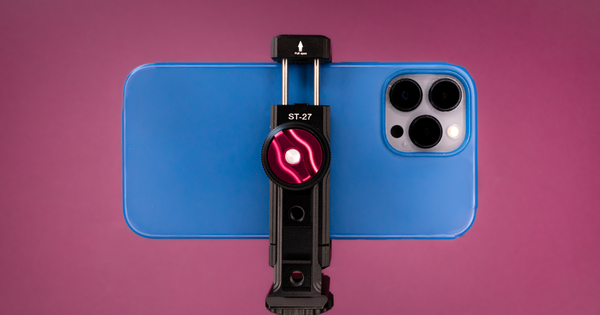
Im Jahr 2020, als Camo es Profis und Kreativen erstmals ermöglichte, die fortschrittliche Kamera ihres Telefons als Webcam zu verwenden, war die Welt der Telefonhalterungen ein dunkler und beängstigender Ort. Bis zu diesem Zeitpunkt war die Befestigung von Telefonen ein Vorgang, der normalerweise Autos vorbehalten war, und die Palette an Saugnapf-, Schwanenhals-, Magnet- und Klebeoptionen waren eigentlich nur (schlecht) auf die Desktop-Umgebung übertragene Telefonhalterungslösungen für Autos.
Glücklicherweise hat sich in den wenigen Jahren seitdem einiges geändert. Einige Telefonhersteller haben beispielsweise damit begonnen, die Funktion „Telefon als Webcam“ direkt in ihre Geräte zu integrieren. Wenn man das mit der enormen Zunahme der Zahl der Menschen kombiniert, die soziale Inhalte direkt auf ihrem Telefon erstellen, erhält man ein schnell wachsendes Universum an videobezogenen Telefonzubehörteilen.
Dieser Leitfaden soll Ihnen dabei helfen, schnell die Auswahl zu durchforsten und die Halterung zu finden, die am besten zu Ihnen passt. Meine Empfehlungen decken eine Reihe von Anwendungsfällen und Budgets ab, aber jede erfüllt die meisten oder alle meiner Hauptkriterien für eine gute Halterung, nämlich schnelle Montierbarkeit, einfache Positionierung und gute Stabilität (Bonuspunkte, wenn sie gut aussieht). Ich habe die Optionen in diese grundlegenden Kategorien unterteilt:
Haftungsausschluss: Diese Studie wurde unabhängig durchgeführt. Reincubate ist mit keinem dieser Produkte verbunden und erhält für die Erwähnung dieser Produkte keine Vergütung.
Ausbalancierte Halterungen und Auslegerarmhalterungen
Budget-Auswahl: Tarion-Ausgleichsarmhalterung ( £28 / $26 )
Profi-Tipp: Ulanzi Gelenkarmhalterung ( 85 £ / 80 $ )
Jeder, der mit der einfachen Arbeitslampe vertraut ist, erkennt das Wunder der industriellen Technik, das der ausbalancierte Arm darstellt. Manchmal auch als Schwebe- oder Schwingarm bezeichnet, ist er ein schönes Beispiel für die Wirkung der Physik, bei der einfache Federn der Schwerkraft entgegenwirken, unabhängig davon, wie der Arm positioniert ist.
Glücklicherweise stellt sich heraus, dass das, was für Lampen und Pixar-Maskottchen so gut funktioniert, auch für die Befestigung von Telefonen ziemlich praktisch ist. Die einfache Klemme lässt sich problemlos an den meisten Schreibtischen befestigen, mehrere Gelenkpunkte ermöglichen es Ihnen, Ihr Telefon ziemlich schnell in den Webcam-Modus zu schwenken, und Sie können es wieder aus dem Weg räumen, wenn es nicht verwendet wird. Kein Ringen mehr mit diesen steifen Schwanenhälsen, die für Autos ziemlich gut geeignet sind, aber auf einem Schreibtisch immer ein bisschen mühsam sind.
Ein weiterer Pluspunkt ist, dass Halterungen mit ausbalanciertem Arm relativ erschwinglich sind. Gebrauchsfähige Modelle sind für etwa 25 £/25 $ zu haben. Seien Sie jedoch vorsichtig bei den supergünstigen Optionen – meiner Erfahrung nach können diese aus minderwertigeren Materialien hergestellt sein, leicht zerbrechen oder aufgrund ihrer Abmessungen für viele Schreibtische zu klein sein. Ich empfehle Ihnen, die Größe vor dem Kauf noch einmal zu überprüfen, immer die Bewertungen zu lesen und bei einem Verkäufer mit guten Rückgabebedingungen zu kaufen, falls Sie mit Ihrer Auswahl nicht ganz zufrieden sind.
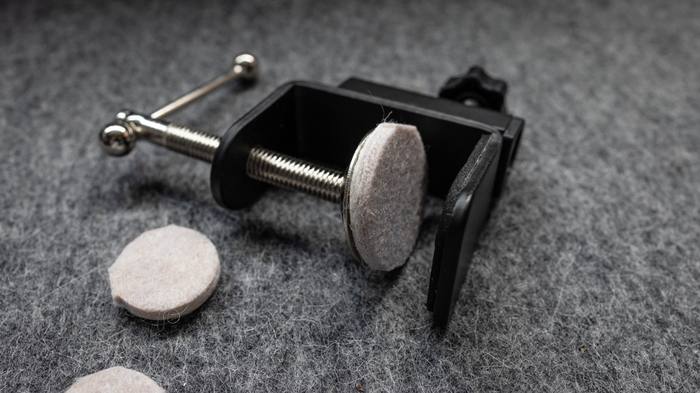
Einfache Halterungen mit ausbalanciertem Arm eignen sich gut für Telefone und relativ kompakte Schreibtischflächen. Wenn Sie jedoch etwas Schwereres montieren möchten oder etwas mehr Reichweite benötigen, sollten Sie ein robusteres Gelenkarmsystem in Betracht ziehen. Diese haben oft eine solide Montagestange, die einen festen Anker für alles von einem Telefon über eine Videoleuchte bis hin zu einem Mikrofon bietet, mit ausreichend Armlänge, um eine Menge Platz zu nutzen. Sie können auch erweiterbar sein – die Basis des Ulanzi bietet Platz für zusätzliche Arme und verfügt oben über einen Befestigungspunkt für die Anbringung einer Videoleuchte. Meine Camo-Kollegin Eden verwendet dieses Modell jeden Tag, um entweder ihr Telefon oder ihre spiegellose Kamera für Meetings und die Erstellung von Inhalten zu halten, und sie liebt es.
Stativbefestigungen
Budget-Auswahl: Etubby-Telefonständer ( £29 / $25 )
Profi-Tipp: Elgato Mini Mount ( 50 £ / 50 $ )
Eine zweite gute Option für Videoaufnahmen am Schreibtisch – und eine, die tragbarer ist als ein Galgenarm – ist die gewichtete Stativhalterung. Es gibt viele Stative, die die gleiche einstellbare Höhe und Stabilität bieten, aber was ich an der einfachen Stativhalterung wirklich mag, ist ihr niedriges Profil. Bei Bedarf können Sie sie vor Ihren Computermonitor stellen und haben trotzdem noch den größten Teil des Bildschirms im Blick. Wenn Sie sie nicht verwenden, stellen Sie sie einfach in eine Ecke des Schreibtischs oder in einen Schrank. Sie brauchen sie unterwegs? Schrauben Sie den Sockel ab und werfen Sie die Teile in Ihr Gepäck.
Wie bei Halterungen mit schwebenden Armen können Ständer in Preis und Vielseitigkeit sehr unterschiedlich sein. Eine Basisoption wie der Etubby-Ständer ist recht erschwinglich, kann aber nichts Schwereres als ein Telefon halten. Auf der anderen Seite gibt es meinen persönlichen Favoriten – die Elgato Mini-Halterung. Sie kostet doppelt so viel, aber dank ihrer robusten Bauweise hält sie alles aus, was ich ihr zumuten kann – das ist alles von einem Telefon über eine APS-C-Kamera bis hin zu einer professionellen Vollsensorkamera mit einem Festbrennweitenobjektiv. Wenn Sie für Ihr Video mehrere verschiedene Kameras verwenden oder dies in Kürze tun möchten, unterstützt diese Halterung sie alle.
Wenn Sie sich für den Standformfaktor entscheiden, hängt die Platzierung davon ab, ob Sie einen Laptop oder einen Desktop-Monitor verwenden. Wenn Sie ihn vor einen großen Monitor stellen, sollten Sie immer noch genügend Bildschirmfläche zum Arbeiten haben. Wenn Sie ihn jedoch mit einem Laptop verwenden, sollten Sie ihn besser hinter dem Computer platzieren, nachdem Sie den Bildschirm näher an die Augenhöhe gebracht haben. Wenn Sie jedoch das Beste aus allen Welten wollen und nur ein wenig mehr Spielraum in Ihrem Budget haben, können Sie mit ein paar gut ausgewählten Zubehörteilen sowohl eine flexible Positionierung als auch eine hohe Tragbarkeit erreichen.
Zubehör
Magische Arme
Lernen Sie den Magic Arm kennen. Dieses nützliche Werkzeug ( 20 £ / 24 $ ) ist seit Jahrzehnten ein fester Bestandteil professioneller Kameraausrüstung, kann aber in seiner kleineren Form erstaunliche Dinge für Ihr Desktop-Video-Setup leisten. Wenn ich einen 9,8-Zoll-SmallRig-Arm auf meine Mini-Halterung setze, kann ich die Positionierbarkeit eines schwebenden Arms mit der Tragbarkeit und Unauffälligkeit eines Ständers kombinieren. Ich kann den Ständer einfach hinter einem Monitor oder Laptop platzieren, den Magic Arm so einstellen, dass das Telefon genau dort hängt, wo ich es vor meinem Bildschirm haben möchte, und dann mit der Arbeit beginnen.
Magic Arms gibt es in verschiedenen Größen und können auch mit Klemmbefestigungen ausgestattet sein, die noch mehr Befestigungsmöglichkeiten für Ihr Telefon eröffnen. Wenn sich beispielsweise über oder hinter Ihrem Computer ein Regal befindet, können Sie möglicherweise einen Arm daran befestigen und ganz auf einen Ständer verzichten. Oder, wenn Ihr Ständer stabil genug ist, können Sie einen zusätzlichen Arm direkt an dessen Rumpf und Halterung befestigen und eine Videoleuchte darauf platzieren. Die Möglichkeiten sind wirklich endlos und ich werde nicht müde, mit meinen kleinen magischen Freunden neue Ausrichtungen auszuprobieren.
Telefonhalter
Wenn Sie eine Halterung kaufen – sei es ein Arm oder ein Ständer –, kann diese mit einer Telefonhalterung geliefert werden, muss es aber nicht. Das ist nicht unbedingt schlecht, wenn dies nicht der Fall ist – Telefonhalterungen unterscheiden sich stark in Qualität, Benutzerfreundlichkeit und Telefonfreundlichkeit, und ich habe festgestellt, dass die Halterungen, die bei preiswerten Halterungen mitgeliefert werden, oft die schwächste Stelle bei der Telefonhalterung sind. Die billigsten gehen leicht kaputt oder verkratzen Ihr Telefon. Alle von ihnen machen ungewollte Screenshots oder versuchen, den Notdienst anzurufen, wenn Sie sie unweigerlich über die Seitentasten Ihres Geräts klemmen.
Damit haben Sie drei Möglichkeiten. Die erste besteht darin, die knifflige Natur dieser Krallen mit Zen-artiger Gelassenheit zu akzeptieren, Ihr Telefon beim Einsetzen durch eine Hülle zu schützen und beim Einstecken Ihres Telefons einfach besonders darauf zu achten, dass die Seitentasten von den hungrigen Zähnen ferngehalten werden.
Die zweite Möglichkeit besteht darin, von den billigeren federbelasteten Klauen auf etwas Robusteres umzusteigen, wie zum Beispiel den Ulanzi ST-27 ( 36 £ / 30 $ ). Der ST-27 ist sicherlich nicht billig, aber das Einlegen eines Telefons selbst mit der dicksten Hülle geht reibungsloser, und ich kann seine Ausrichtung mit einer schnellen Drehung meines Handgelenks leicht ändern. Aus irgendeinem Grund hat es Gummizähne, aber keine gepolsterte Rückseite, also habe ich zum Schutz meines Telefons ein kleines selbstklebendes Rechteck aus Filzpolster angebracht.
Die letzte Option ist nur für diejenigen reserviert, die ein iPhone mit MagSafe-Funktionen verwenden. Anstelle einer Halterung in Klauenform können Sie sich auch für eine einfachere, flache Montagescheibe wie diese von Neewer ( 21 £ / 20 $ ) entscheiden. Schrauben Sie sie einfach an den Kugelkopf Ihres Arms oder Ihrer Stativhalterung (oder an das Ende Ihres Magic Arms), und schon können Sie Ihr Telefon einrasten lassen, ohne dass Sie dafür kämpfen müssen. Für Android-Benutzer werden Scheiben wie diese oft auch mit einem kleinen Klebering geliefert, der angeblich jedes Telefon MagSafe-kompatibel macht, aber im Allgemeinen empfehle ich nicht, etwas direkt an Ihr Telefon zu kleben, es sei denn, Sie haben nichts gegen kosmetische Schäden.
Aber selbst für iPhone-Nutzer ist meine Empfehlung einer MagSafe-Montagescheibe mit einer Einschränkung verbunden. Immer wenn ich ein iPhone über diese MagSafe-Option montiere, frage ich mich unweigerlich, ob ich es nicht gleichzeitig aufladen sollte, sodass ich mich an Besprechungen beteiligen oder mit Videos arbeiten kann, ohne mir Gedanken über die Akkulaufzeit machen zu müssen. Aber leider scheint es bisher kein einfaches MagSafe-Zubehör zu geben, das Ihr iPhone auf Augenhöhe hält und gleichzeitig auflädt, abgesehen von einigen improvisierten 3D-gedruckten Halterungen auf Etsy .
Ultrakompakte Montierungen
Natürlich kann es Momente geben, in denen Sie einfach nicht den Platz oder die Zeit haben, Ihr Telefon mit einer der Optionen zu befestigen, die ich bisher empfohlen habe. Wenn Sie etwas Schnelles und Taschentaugliches brauchen, das Sie unterwegs mit Ihrem Laptop verwenden können, gibt es ein paar gute Optionen.
Ausschließlich für iPhones mit MagSafe gibt es kompakte Modelle wie die MagSafe-Halterung von Belkin ( 29 £ / 28 $ ), die vor ein paar Jahren zusammen mit der Veröffentlichung der Continuity Camera-Funktion von macOS Ventura auf den Markt kam. Natürlich gibt es viel zu sagen darüber, wie Continuity im Vergleich zu Camo abschneidet , aber ich kann mit Freude sagen, dass die Belkin-Halterung und ähnliche Halterungen unabhängig von der verwendeten Videosoftware funktionieren.
Sobald Sie Ihr Telefon an der Halterung befestigt haben, können Sie es ganz einfach auf Ihrem Bildschirm platzieren. Für die meisten Benutzer bedeutet dies, dass Ihr Video von einem Punkt weit unterhalb der Augenhöhe aufgenommen wird. Ich empfehle daher, den Laptop auf ein paar Bücher oder eine andere kleine improvisierte Plattform zu stellen. Dabei geht es auch um praktische Aspekte – wenn Sie Ihren Laptop anheben, bleibt sein Bildschirm so vertikal wie möglich, was ich bei der Verwendung beider Halterungen dieser Kategorie als ziemlich wichtig empfand. Wie Sie vielleicht erwarten, wenn Sie etwas so Massives wie ein iPhone oben oder seitlich an Ihrem MacBook-Bildschirm aufhängen, verschiebt sich der Schwerpunkt ziemlich stark, wenn sich der Bildschirm von der Senkrechten entfernt.
Für Android-Nutzer ist die beste kompakte Option, die ich verwendet habe, eine faltbare Halterung in Kreditkartengröße wie diese von Tagplus . Wenn Sie sie nicht benötigen, können Sie sie zusammen mit Ihrem Rest der Kartensammlung in Ihrer Brieftasche verstauen. Wenn Sie dann Zeit für ein Video sind, nehmen Sie sie einfach heraus, klappen die größeren Arme nach außen, um Ihr Telefon zu halten, und die kleineren Arme nach innen, um die Oberseite Ihres Laptop-Bildschirms zu greifen. Es ist nicht das robusteste Stück Technik, aber ich habe bei meinem nach anderthalb Jahren gelegentlicher Verwendung noch keine Abnutzungserscheinungen gesehen. Eine letzte Anmerkung ist jedoch zu beachten – sowohl für diese als auch für jede andere Halterungsoption, die direkt auf Ihrem Laptop-Bildschirm sitzt –: Wenn Sie auf einer Laptop-Tastatur tippen, während eine dieser Halterungen montiert ist, kann dies zu Verwacklungen der Kamera führen. Aus diesem Grund und auch, weil Sie Ihren Laptop zusätzlich anheben müssen, um einen guten Winkel zu erhalten, empfehle ich ultrakompakte Halterungen nur für Situationen, in denen sie unbedingt erforderlich sind.
DIY-Halterung
Und nun zur letzten Grenze der Telefonmontage: Selbermachen. Vielleicht haben Sie sich alle Optionen angesehen, die ich hier besprochen habe, und gedacht, Sie könnten es besser machen. Vielleicht möchten Sie nichts, was tausend andere Leute haben. Vielleicht haben Sie einen Stapel Legosteine herumliegen und fühlen sich inspiriert. Vielleicht langweilen Sie sich.
Aus solch fruchtbarem Boden sprießt Inspiration. Im Laufe der Jahre haben viele Benutzer ihre einzigartigen Kreationen mit uns geteilt, und in der Hoffnung, dass sie Sie wiederum inspirieren könnten, zeige ich hier einige davon. Wenn Sie selbst eines herstellen, senden Sie uns bitte ein paar Bilder, mit oder ohne Investorenprospekt.
Das ist fürs Erste alles! Wenn neue Montageoptionen auf den Markt kommen, werde ich jede auf Herz und Nieren prüfen und meine Empfehlungen entsprechend aktualisieren. Wenn Sie in der Zwischenzeit Optionen gefunden haben, die hier nicht aufgeführt sind und für Sie gut geeignet sind, oder wenn Sie Fragen haben, lassen Sie es mich einfach in den Kommentaren unten wissen. Ich freue mich immer, mit meinen Mounties-Kollegen übers Geschäft zu reden.
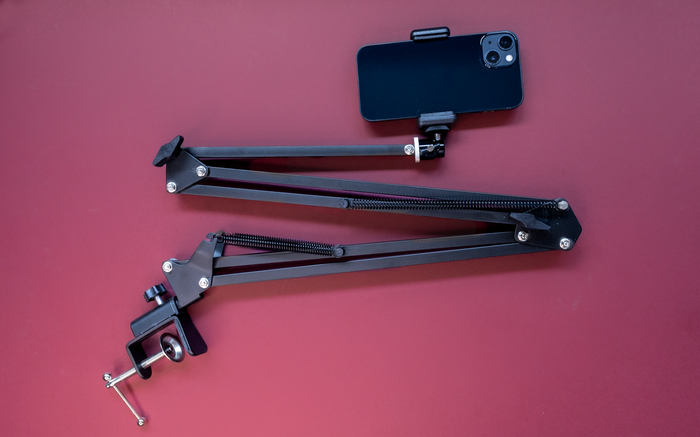
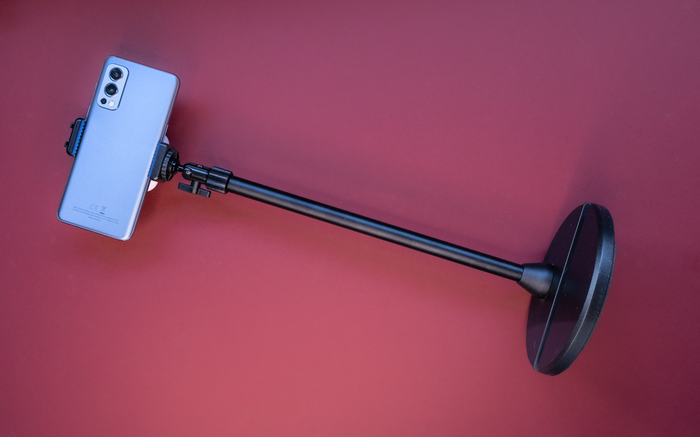

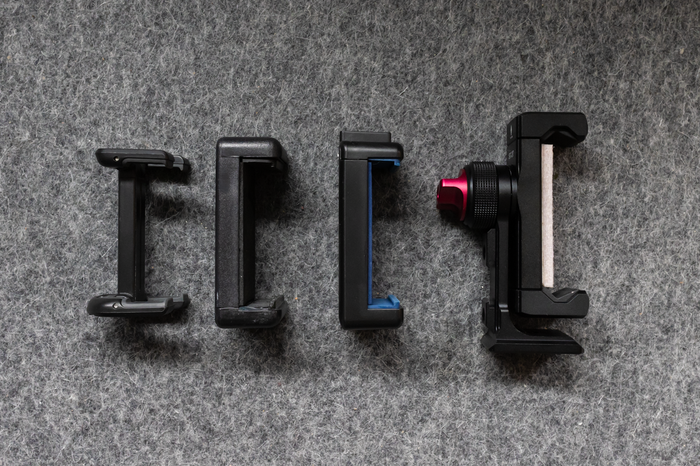
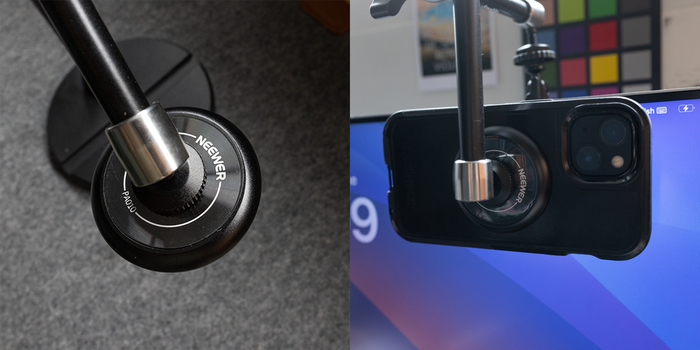
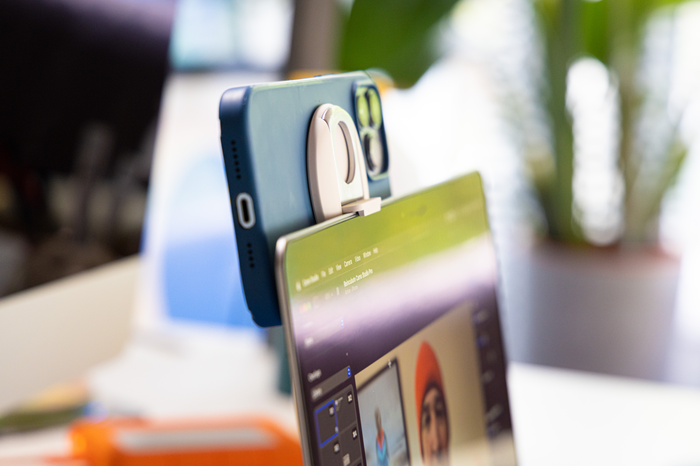
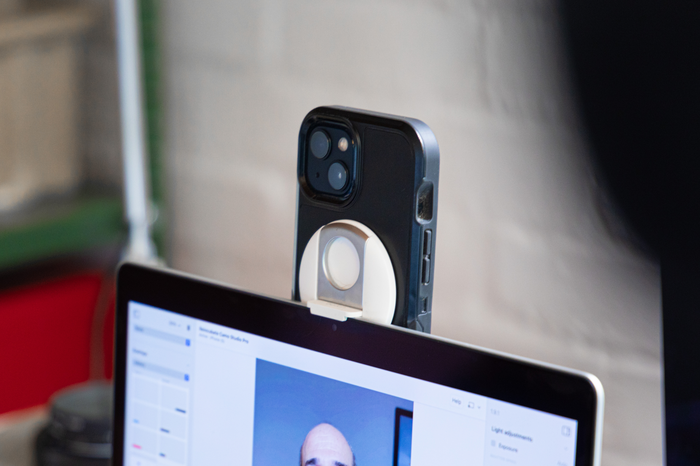
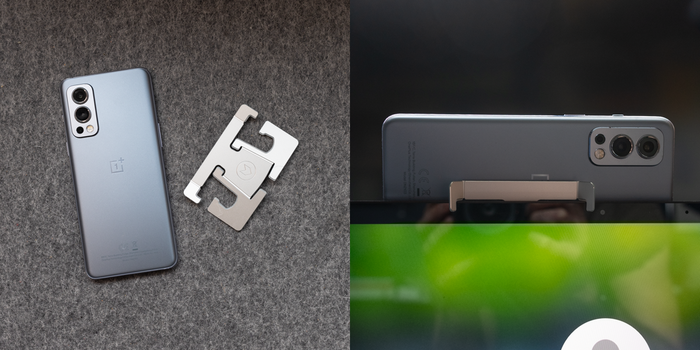
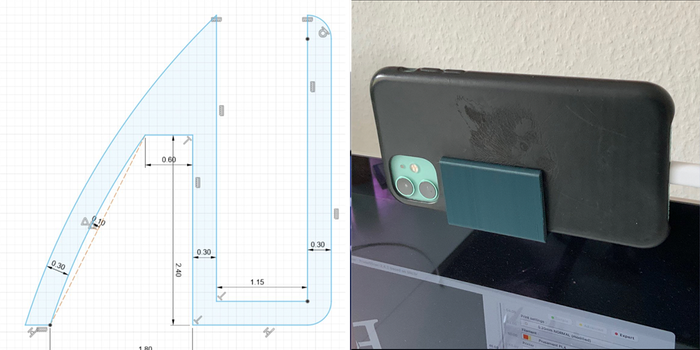
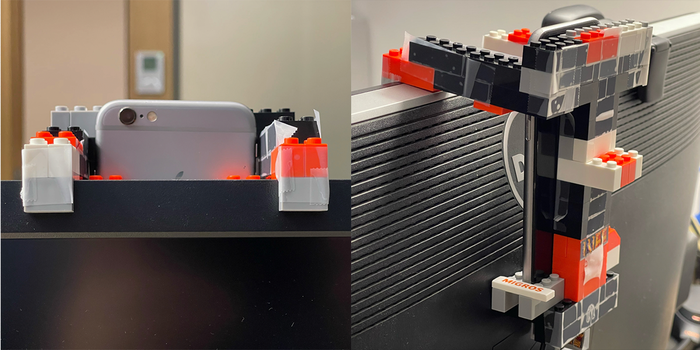
. The *Net Scape Raft Videocam Support System.™* Captain: [HyperTextHero](https://hypertexthero.com/hypertexthero-lego-camera-holder/).](https://i.reincubate.com/ssm/lego-mount-3.png)

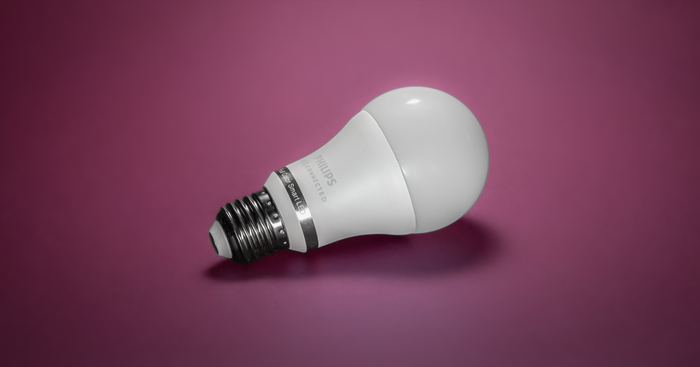
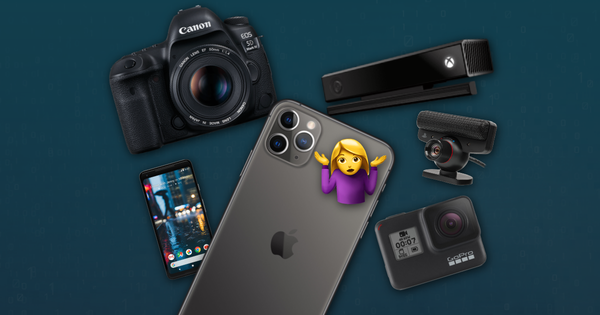
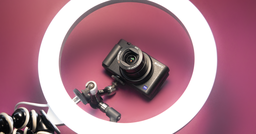
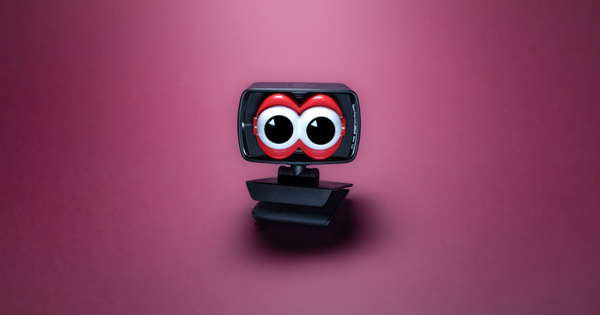
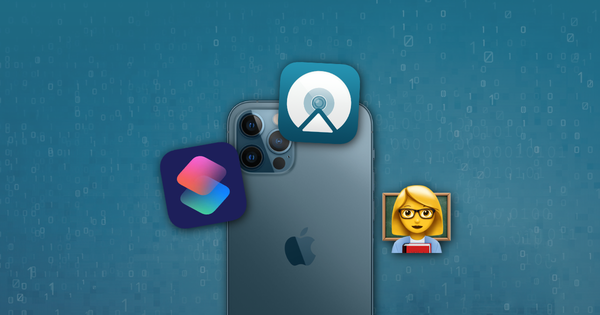

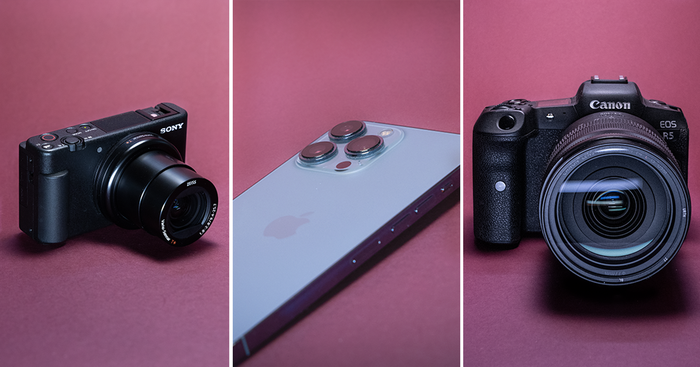
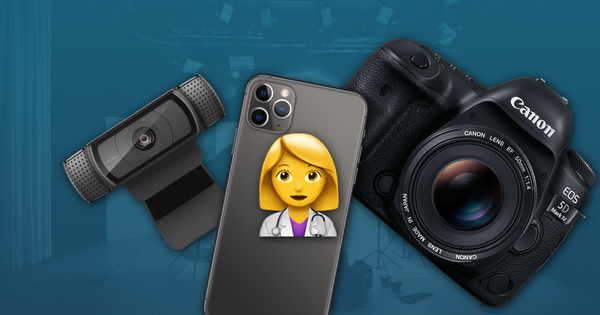
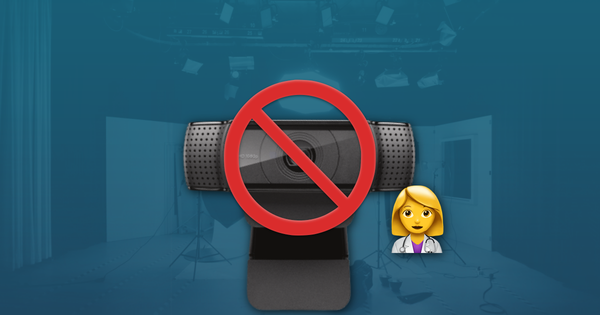
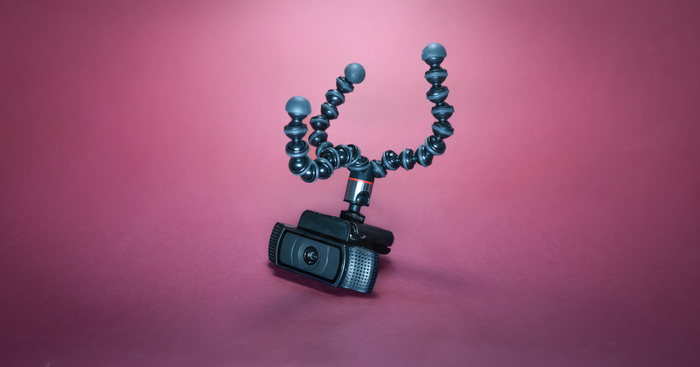
von Dean Brady
SmallRig also makes a variety of mounts and cages that can work if you are using a spare phone and want something more permanent. Their magic arm combined with any number of other desk, ceiling, tripod mounts can be perfect for any situation.
I found my old Samsung NOTE and S20 Ultra make amazing cameras - even with cracked screens :-)
One note for me, I found that some tables/mounts are prone to shock and can make the camera bounce... just something to be aware of.
antworten Sie mit: Reincubate Support
Thank you Dean! We put a stabilization mode into Camo (it's under the "framing" options) to deal with issues we saw in wobbly tables and standing desks.
von Dean Brady
The two best mounts I've found (for me) are from Doolkin on Amazon. https://www.amazon.com/gp/product/B09WTD517N/ref=ox_sc_act_title_1?smid=A303MVJ19XSJH1&th=1
https://www.amazon.com/gp/product/B0BHKH74WC/ref=ox_sc_act_title_2?smid=A303MVJ19XSJH1&psc=1
The first has a great feature in you can remove the arm and buy another magnet and use it on multiple devices. The one issues is that you may not get as much adjustment on the angle so make sure you mount it after testing the angle.
The second one has a mount that allows you to swivel it all the way around which means I can use either the selfie camera or the back cameras! But, it is a sticker mount and isn't removable to move to another device. That may not be a big deal but I've messaged the manufacturer and asked them to combine the two. That with Camo Studio would be AMAZING.
von Graham Rose
Its not an amazon find, and its often out of stock - but for 24.99 canadian this mount/ring light combo from Ikea is pretty solid - ive been using it for a while, and the ring and arm use 1/4" - 20 threads, so in theory you could use them with a ton of photography clamps etc.
https://www.ikea.com/ca/en/p/lanespelare-ring-light-with-phone-holder-30514357/
von Gabriel
Hello,
Just as this article does, I was also looking to find the "best" way to mount a phone on a laptop or monitor. I guess the difference is that I was not willing to buy and try all the mounts available out there :). Nonetheless, thanks for the great, in-depth review.
All that said, I thought I would develop one myself, starting with a few requirements. It has to work in any setting: primarily on laptops and monitors but also on standup tables and workbenches, in the car, on a server rack, on a wall and other furniture. It must be usable with any type of phone, whether in a case or without one. It must have exactly zero tightening knobs or levers. It must be cool - for some reason (I am guessing the reason is cost) all mounts I've seen are monochromatic or in a gray scale at best. Anyone with enough patience and some minimum engineering skills :) should be able to make one at home using common materials. The design must be easy to update and the changes easily implemented.
The result is a 3D-printed phone mounting system. If you're curious to see, I placed some pictures on my web site: https://rail-mounted.com/.
There's a contact page on that site if you want to let me know your thoughts.
Thanks, gabriel
von Jordan
Great article and a lot of helpful suggestions, just none of them worked for me.
I ended up using some velcro locking strips I had around the house.
I was able to cut a strip in half and mount my iPhone SE (1st gen) on top of my monitor. This is a clean look and no wobble. Also, low cost.
von Govind Rai
Thank you so much for this article. Buying anything is such a hassle for me, and this is exactly the sort of homework I do before getting anything. Appreciate it!
von Paul Calamai
An expensive alternative but one worth considering if you want to add a mic and you are using an M1 based Apple computer is the Sennheiser MKE 200 Mobile Kit
von Steve King
Another vote for Mountie. Been using for over a year with my iPhone 11 then 12 and never had any issue with it pulling my Macbook screen down. I usually mount it to the top so that the camera is directly above the Facetime camera. Fantastic.
von Donald Smith
This is seriously one of the most thoughtful articles I have seen any brand/company post. This is exactly what I was looking for. Having just paid for lifetime premium, I was looking for a more permanent solution to attach a spare phone to my LG 5k display. I ended up choosing the FLOVEME Sticker mount, as it was perfect for my use case.
In general, I am blown away at the attention to detail and app quality, both on iOS and MacOS, with Camo. I am excited for more amazing development from this team on this product. I hope more and more people support your team. Great work
von Mark D
Hi - have you checked out the Mountie or Mountie+ by Ten One Design?
I've had my eye on them for a while now, and having just signed up for Camo today also treated myself to a Mountie. Will let you know how well it works once it arrives in a few weeks.
antworten Sie mit: Reincubate Support
Thank you, please do! We're wary of devices like Mountie that clip to the screen. As we noted in the article, these pulled our laptop screen down or pulled the laptop over, and they put the device to one side of the screen, rather than just above the eyeline. That said, if you have one of the smaller phones and one of the larger laptops, it'd probably be fine. Just don't damage that screen!!!
von Matthew S
I've been using a selfie-stick velcro-strapped to my monitor stand (LG 5K) It's a little wobbly when adjusting, but it's height-adjustable and I can flip the phone around easily.
von samwzlim
I don't usually comment on articles, but this one was so well written and really helped me, thank you so much!
von Nafyyyyyyyy
Hey cool -- I was messing around with my own setup for videos/blogging and was thinking there has to be other ways to use my old iPhone as a webcam.
Currently using a desk mount - but intrigued by what you put on the monitor mounts and mechanical arms.
THXXXXXXXXXXXXXXXXXXXXXXXX
antworten Sie mit: Reincubate Support
Hey, our pleasure. 👍
von NickB
Really helpful article. Thank you so much!
antworten Sie mit: Reincubate Support
Thank you! 👍
von Andy Beers
This article rules -- super great stuff!
antworten Sie mit: Reincubate Support
Thank you! 🙂
von stephen
Brilliant article - put me, I hope, on the right track!
von Kelvin lui
An incredibly well-researched and resourceful article. Thank you for saving us hours of time from being drowned in endless “recommendations” and marketing websites
von Grover
Great article, but an important note about your TL;DR recommended flex arm. The clip that hold your phone is pretty shallow and if you have a case of any substance at all on your phone, you'll struggle to keep it in there. Mine is relatively minimal, but thick enough that if I jiggle my desk a bit, my phone will sometimes come shooting out of it. Taking my case on and off negates a lot of the convenience of the spring-loaded clip in the first place.
Studio Neat's Glif is a bit pricey, but impossible to beat for quality and function and works with any case you could imagine: https://www.studioneat.com/products/glif
I took apart a $5 gooseneck lamp and glued a 1/4" tripod thread to make a Gif-based mount I'm pretty pleased with overall. FWIW.
antworten Sie mit: Reincubate Support
Thank you! Great tip. 🙂
von Schole
Another webcam mount: https://www.amazon.com/AboveTEK-Aluminum-Folding-Display-Reception/dp/B074PFVVBH
antworten Sie mit: Reincubate Support
Thank you!